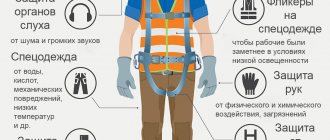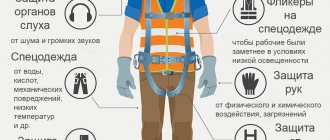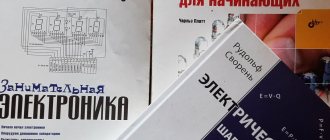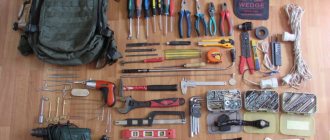When repairing, connecting, or maintaining electrical equipment and networks, even when the voltage is removed, there is a possibility of receiving an electric shock. There is a risk that someone will turn on the switch or press the starter button; you may trip and touch live conductive surfaces. Based on this, current electrical safety rules require the mandatory use of PPE that can prevent electrical injuries or reduce the severity of damage.
Purpose
Complete with collective protective equipment, PPE is designed to ensure safe working conditions for one specific performer. That is, they can only protect the electrician who uses them.
Personal protective equipment for electrician
In practice, two main types of PPE are used, which differ in their operating principle:
- Insulating protective equipment prevents electric shock from direct contact with live parts of electrical installations. This category also includes means that provide insulation from the ground. Variants of such PPE are made using materials of the dielectric group, whose resistivity exceeds 108 Ohm*m.
- Fencing is required to prevent contact with parts of electrical equipment that may be live. Such PPE includes safety belts, claws, and barriers installed at work sites.
Every electrician must know the rules of use and the list of personal protective equipment required depending on the conditions of work. In addition, he needs to be able to check all the means at his disposal and have information about the frequency of tests that are carried out by specialized organizations.
PPE standards for electricians
Frequency of inspection of fire extinguishers and maintenance schedules
According to the standards and GOST, the PPE of an electrician for the repair and maintenance of electrical equipment must be fully or partially made of materials that do not conduct electricity.
List of PPE for electricians according to industrial safety standards:
- protective glasses;
- special suit;
- respirators;
- mask;
- dialectical gloves or mittens;
- galoshes.
Any protective equipment must comply with the established requirements of TR TS019/2011. It specifies not only the requirements for PPE against electric shock, but also the completeness, as well as the quantity (and timing) of issuance per employee and the frequency of checking PPE.
Classification
Current regulations also provide for the classification of PPE according to purpose and permissible conditions of use. It is customary to subdivide into:
- Basic electrical protection necessary for carrying out work in the presence of voltage on live parts of equipment or networks. The main requirement for such products is that they must have insulating characteristics that will allow them to withstand the voltage present for a long time.
Basic PPE - Additional electrical protection, which by themselves cannot protect a person from prolonged contact with live parts of equipment or mechanisms. They are used only in conjunction with basic personal protective equipment and are able to prevent injury when exposed to step voltage or accidental contact with conductive elements (touch voltage).
Additional PPE
Each of the listed types, in turn, is divided into categories according to the permissible voltage at which their use is possible. There are two groups:
- PPE that allows you to perform electrical installation work or repairs, equipment maintenance at a voltage not exceeding 1 kV.
- Personal protective equipment for working on high-voltage installations or networks at voltages over 1 kV.
The main differences between the products of these groups are the quality of the dielectrics used. Note that the main tools and devices intended for up to 1 kV can be used as additional ones if the indicator exceeds this limit.
Basic PPE
The most common types used for working with equipment or electrical networks at voltages up to 1 kV include:
- Operating rods necessary for performing operations related to the maintenance or control of electrical installations. With their help, switching operations with disconnectors and grounding connections are carried out. They are a handle made of a material with dielectric properties on which an actuator or gripper is installed.
Operating rods - Measuring rods have a similar design, but instead of grippers they are equipped with equipment for measuring resistance, voltage, temperature, current, and other characteristics. Universal rods that combine the capabilities of operational and measuring devices have also found application.
High voltage measuring rod - Insulating pliers are designed to replace fuse links, busbar fuses and to perform other maintenance operations on live electrical equipment. The difference with operating rods is that they are a pliers tool with two long, insulated handles that allow you to perform work at a distance from parts of the equipment.
Insulating pliers - Electrical measuring instruments designed to take readings directly from conductive elements or contacts of electrical equipment. Clamps for determining current strength, megohm meters for monitoring insulation resistance, voltage indicators (VT) and other devices for monitoring the parameters of electrical circuits.
Electrical measuring instrument - Dielectric gloves also belong to the main types of personal protective equipment for work at voltages not exceeding 1000 V. Like other insulating clothing, they are used exclusively in a dry state, even the minimal presence of moisture on the surface can cause electric shock to the performer (the table with the date of the last check is shown in black , inspection organization, etc.).
Dielectric gloves - Part of the PPE consists of insulated hand tools, which every electrician who performs maintenance, repairs, connecting electrical equipment and when working with electrical networks should have. This list includes screwdrivers, pliers and pliers, pliers and side cutters. Open-end or socket wrenches, knives or strippers, and other devices are also used. It is recommended to use hand tools with VDE marking that comply with European electrical safety requirements. It is distinguished by multi-layer coating of hazardous areas with insulating materials. Moreover, the main protection is the top layer of polyformaldehyde, which has high dielectric characteristics.
Isolated hand tool
Please note that when working at high-voltage installations, these basic personal protective equipment cannot ensure complete safety of work. If the value exceeds 1000 V, it is necessary to use specialized personal protective equipment:
- Rods and clamps whose insulating characteristics provide long-lasting protection against high voltage.
- Special devices and structures that should ensure the safety of measurement work. These include tools for piercing insulation, high-voltage electrical clamps and UN.
- To work on installations and networks with a voltage class of more than 110 kV, non-contact measuring devices are used, for example, voltage indicators.
Please note that only electricians with the appropriate permit can be involved in carrying out work in such conditions.
Additional protections
This category of PPE is also divided according to the permissible voltage at the work site. The difference lies in the dielectric characteristics, so we will give only a general list, but you should check the conditions under which they are intended:
- Protective dielectric footwear (boots, galoshes), which allow you to avoid the passage of currents through the body that are shorted to the ground. Such products are recommended for use in premises and kiosks in cases where the floor is made of conductive materials.
Dielectric safety shoes - Dielectric mats and insulating stands have a similar purpose. Can be used both indoors and outdoors, but only in dry weather.
- Insulating caps or covers to prevent equipment from turning on and causing electrical power to enter the work area.
Insulating hoods - Specialized suits, safety glasses, helmets to avoid injury in the event of discharges and other emergency situations.
- Portable structures and devices for fencing and grounding of conductive parts of serviced equipment.
Portable ground electrodes
It is recommended to use a combination of primary and several auxiliary PPE.
Types of PPE for electricians and their use
Testing of fire escapes and roof railings: inspection frequency
To ensure the safety of working with electric current, every electrician or technical engineer at the enterprise must receive personal protective equipment and receive instructions for their use.
A mandatory element of equipment at many factories is a dielectric helmet. It will protect your head from mechanical damage or electric shock. The helmet is equipped with special insulation that protects against high voltage.
Helmet
Special openings for ventilation are installed in the side parts, which, if necessary, can be covered with shields. The helmet is secured on the head with adjustment straps and a forehead band.
Protective glasses
Glasses are a mandatory element of PPE for an electrician. They are made entirely of plastic, since metal parts are not allowed by regulations. There are clamps installed on the earpieces to prevent the glasses from falling. This is especially true if the electrician works at high altitudes.
Note! The lenses are made of high-strength transparent plexiglass. The glasses fit tightly to the head, and therefore the eyes will be completely protected from various small objects.
Work suit
Electrician PPE is made of dense material. Before release into production, specialists conduct tests to ensure that the work suit can protect a person from an electric arc.
Electrician suit
Electricians must be equipped with winter and summer work clothing. Jackets must have several pockets where you can place small tools: screwdrivers, pliers, etc.
Respirator
Serves to protect the respiratory system from dust or gases. Respirators are equipped with varying degrees of filtration depending on the specific model.
According to the standards, respirators must fit completely to the face, and therefore you need to look for a model that is most suitable for a specific head size.
Mask
Another mandatory piece of equipment that every electrician at an industrial enterprise must be provided with.
A gas mask will be needed if an emergency occurs at work with the release of a substance harmful to the body. Thanks to special filter elements, the human respiratory system will be protected.
Important! The gas mask must be checked regularly and do not forget to change the filters after the expiration date.
Mittens and dielectric gloves
Mittens should be used if rough or heavy work with your hands is to be done; they protect the skin from cuts. If there is work to be done in winter, then electricians should be given gloves and insulation from the inside with fur.
Dielectric gloves
Dielectric gloves protect a person from electric shock. Products are made of rubber and can have different shapes:
- two-toed;
- five-fingered.
According to the manufacturing method, they are divided into seamless and suture. Dielectric gloves are equipped with markings (the explanation can be found in the instructions), which contains information about what voltage they can work with.
Dielectric galoshes
In addition to goloshas, the employee must be given shoes once a year. It should not contain metal fittings. The boots are made from genuine leather because it is non-flammable.
For your information! Galoshes are worn to protect against step voltage.
Check before use
Before each use, the electrician must make sure that the period of the next PPE test has not passed; this information is indicated on special stamps. In addition, an external inspection is mandatory, and if damage to the insulating coatings is detected, the products must be sent for extraordinary testing. Dielectric gloves are additionally checked for leaks by filling them with air and twisting them. If leaks are detected, use is unacceptable.
We pay attention to the correct selection of personal protective equipment depending on the conditions of use, compliance with the frequency and procedure for carrying out inspections or tests. Violations in these matters will cause electrical injuries, including death.
General labor protection requirements
1.1. This instruction has been compiled on the basis of the “ Rules on labor protection during the operation of electrical installations ”, approved.
By order of the Ministry of Labor of Russia dated December 15, 2020. No. 903n (Registered with the Ministry of Justice of Russia on December 30, 2020 No. 61957), “Rules on labor protection in housing and communal services,” approved. By Order of the Ministry of Labor of Russia dated October 29, 2020 No. 758n (Registered with the Ministry of Justice of Russia on December 7, 2020 No. 61295) (hereinafter referred to as the Rules). When performing work at height, it is additionally necessary to undergo training in accordance with the requirements of the “ Rules on labor protection when working at height ”, approved. by order of the Ministry of Labor of Russia dated November 16, 2020 No. 782n (Registered with the Ministry of Justice of Russia on December 15, 2020 No. 61477).
1.2. Persons who have undergone a preliminary medical examination and have no contraindications to performing this work, have been trained in a special program at an educational institution and have a standard certificate for the right to repair and maintain electrical installations are allowed to work as an electrician for the repair and maintenance of electrical equipment (hereinafter referred to as an electrician).
1.3. Electrical safety group III may only be assigned upon reaching 18 years of age.
1.4. Before being allowed to work independently, an electrician must pass:
- introductory and initial training at the workplace on labor protection and fire safety;
- internship with on-the-job training under the guidance of an experienced employee, for from 2 to 14 shifts. The duration of the internship is determined by the order of the head of the structural unit;
- training in methods of freeing a victim from the effects of electric current, taking into account the specifics of maintained (operated) electrical installations, providing first aid to victims at work;
- training in safe methods and techniques for performing work in electrical installations on labor protection ;
- testing of knowledge on labor protection, fire safety, as well as admission to the electrical safety group in the organization’s commission, with the registration and issuance of appropriate certificates. If an electrician has the right to carry out special work, then the certificate for testing knowledge of the rules of working in electrical installations must contain a record of this. In case of receiving an unsatisfactory assessment based on the results of the knowledge test, the electrician is obliged to undergo a repeated knowledge test within a period of no later than 1 month. The issue of the possibility of maintaining an employment contract with an employee who has not passed the exam for the second time is decided by the employer in the manner prescribed by law;
- duplication under the supervision of the person responsible for training the backup - for from 2 to 12 work shifts. The person responsible for training the backup and the duration of backup is determined by order of the head of the structural unit;
- control individual emergency and fire training (during the duplication period).
1.5. If during the duplication process the electrician has not acquired sufficient production skills or received an unsatisfactory assessment in individual control training, the duplication may be extended, but not more than the main duration and additional training. If during the duplication period the professional unsuitability of the electrician is determined, he is removed from training. The issue of his further work is decided by the employer in accordance with the legislation of the Russian Federation.
1.6. In case of positive results during the duplication period, the electrician is allowed to work independently.
1.7. After being allowed to work independently, the electrician goes through:
- repeated briefings on labor protection and fire safety – once every 3 months;
- unscheduled briefings upon the introduction of new or revised norms and rules, labor protection instructions, as well as changes to them; when changing the technological process, replacing and modernizing equipment, devices and tools, raw materials, materials and other factors affecting labor safety; in case of violation by an employee of labor safety requirements, which can lead or have led to injury, accident, explosion or fire, poisoning; during breaks in work for more than 30 days; at the request of state supervisory authorities;
- targeted briefings when performing work according to work permits and orders; when performing one-time work not related to direct duties in the specialty; when eliminating the consequences of accidents, natural disasters, catastrophes; when conducting an excursion in an organization;
- special training – once a month;
- emergency training: at least once a quarter;
- fire training: at least once every 6 months;
- professional additional education for continuous professional development;
- regular knowledge testing at least once every 12 months;
- periodic medical examination.
In case of violation of labor protection rules, depending on the nature of the violation, an extraordinary knowledge test or unscheduled briefing is carried out.
1.8. An electrician must know:
- labor safety instructions for an electrician for the repair and maintenance of electrical equipment;
- instructions from manufacturers for the operation of the equipment, tools, technological equipment, and materials used;
- instructions for the use of protective equipment;
- instructions on labor protection when working with hand-held blacksmith's tools;
- instructions on labor protection when working at height;
- instructions on labor protection during loading, unloading and warehouse operations;
- instructions on labor protection when working with hand-held electric tools;
- fire safety instructions;
- instructions for providing first aid in case of accidents at work;
- dangerous and harmful production factors associated with the work performed.
1.9. The electrician is obliged to observe the work and rest regime:
- working hours from 8-00 to 17-00; lunch break from 12-00 to 13-00.
Possibly, involvement in overtime work in accordance with the Labor Code of the Russian Federation.
1.10. The electrician is obliged:
- comply with the requirements of these instructions;
- use personal protective equipment correctly;
- undergo training in safe methods and techniques for performing work, briefings on labor protection and fire safety, on-the-job training, knowledge testing, duplication, emergency and fire training, special training, advanced training;
- immediately notify the immediate or superior manager about a situation that threatens the life and health of people, about every accident at work, about all violations of labor protection requirements noticed by him, malfunctions of equipment, tools, devices, personal and collective protective equipment, as well as about the deterioration of his health;
- undergo mandatory preliminary and periodic medical examinations;
- know the rules and procedures for behavior in case of fire;
- be able to use primary fire extinguishing means;
- do not allow unauthorized persons into the workplace;
- smoke in designated areas;
- do not allow drinking alcoholic beverages in the workplace during working hours;
- be able to provide first aid to victims of industrial accidents;
- keep the workplace clean and avoid clutter;
- keep work clothes, safety shoes, and other protective equipment clean.
1.11. When operating electrical installations, an electrician may be exposed to harmful and (or) hazardous production factors, including:
- coolant (steam, hot water), chemical reagents in case of possible destruction of elements of thermal power plants and pipelines;
- increased temperature of the outer surface of thermal power plants and pipelines;
- increased air temperature in working areas;
- increased contamination of the air in working areas with fuel gas;
- insufficient illumination of work areas;
- increased levels of noise, vibration and radiation in the workplace;
- moving moving parts of thermal equipment (compressors, pumps, fans) and tools;
- falling objects (equipment items) and tools;
- location of workplaces at a significant height (depth) relative to the floor surface (ground);
- electric shock.
1.12. Adverse production factors, based on their resulting effects on the human body, are divided into:
- Harmful occupational factors (OHF) are factors that lead to illness, including those that aggravate existing diseases.
- Hazardous occupational factors (OHF) are factors leading to injury, including death.
1.13. Harmful production factors , based on their impact on the working person’s body, are divided into:
- Factors leading to chronic diseases, including aggravating existing diseases, due to long-term, relatively low-intensity exposure;
- Factors leading to acute diseases (poisoning, injuries) or injuries due to short-term (single and/or almost instantaneous) relatively high-intensity exposure.
1.14. Hazardous production factors based on their impact on the working person’s body are divided into:
- Factors leading to fatal injuries (fatal outcome, death);
- Factors leading to non-fatal injuries.
1.15. An unfavorable production factor of the same nature, with different characteristics of the impact, can turn out to be either harmful or dangerous, and therefore the logical boundary between them is arbitrary.
The expression “dangerous and harmful production factors” describes the entire set of unfavorable production factors and emphasizes the greater importance of “dangerous” factors that can lead to sudden death compared to “harmful” factors.
The expression “harmful and (or) dangerous production factors” also describes the entire set of unfavorable production factors, but emphasizes not only the difference between “harmful” or “dangerous” factors, but also the possibility of “harmful” factors becoming “dangerous”.
1.16. When performing work in accordance with the type of dangerous and harmful production factors, the electrician is required to use personal protective equipment (working clothing, safety shoes and safety devices: goggles, respirator, headphones, etc.) (hereinafter referred to as PPE).
1.17. The list of provisions for the free issuance of PPE to electricians has been approved by the “Standard for the provision of personal protective equipment (PPE) to employees of JSC Belgorod Regional Heating Network Company.”
1.18. To protect against the effects of hazardous and harmful production factors, an electrician must comply with the following rules for the use of PPE:
- when servicing rotating mechanisms, there should be no flying parts of clothing that could be caught in the moving parts of the mechanisms;
- if it is necessary to be near hot parts of equipment, measures should be taken to protect against burns and high temperatures (equipment enclosure, ventilation, warm clothing);
- when performing work at sites with air temperatures above +33 °C, it is necessary to observe a work schedule with time intervals for rest and cooling;
- when staying in rooms with operating technological equipment (except for control panels), it is necessary to wear a protective helmet to protect the head from impacts from random objects;
- if there is insufficient illumination of the work area, additional local lighting should be used (lanterns, portable electric lamps);
- To protect against electric current, electrical protective equipment should be used: dielectric gloves, galoshes, mats, stands, pads, caps, portable grounding devices, voltage indicators, plumbing tools with insulating handles and safety signs.
1.19. In electrical installations, people, machinery and lifting machines are not allowed to approach live, unprotected live parts.
1.20. It is not allowed to block the approaches to panels with fire-fighting equipment and to fire hydrants, as well as to use fire-fighting equipment for other purposes.
1.21. If faulty devices, tools and protective equipment are detected, the electrician for the repair and maintenance of electrical equipment must report this to his immediate supervisor. Working with faulty devices, tools and protective equipment is not allowed.
1.22. To avoid electrical shock, do not touch or step on dangling wires.
1.23. It is prohibited to use tools, devices, work on equipment that the employee has not been trained or instructed to handle, as well as with faulty equipment, tools and devices, as well as personal and collective protective equipment.
1.24. For violation of the requirements of these instructions, the electrician is liable in accordance with the current legislation of the Russian Federation.
Frequency of inspections and tests
In accordance with current standards and rules, a clear frequency of testing and inspection has been defined for PPE used in work. Mandatory regularity of operational tests:
- Every six months, dielectric gloves are subjected to such a check.
- Every year it is necessary to test insulated hand tools, protective overshoes, measuring rods, including high-voltage voltage regulators.
- Every 2 years, current and insulating clamps and operating rods are checked.
- Dielectric boots must be tested at least once a year.
Labor protection requirements during work
3.1. An electrician for the repair and maintenance of electrical equipment should carry out walk-throughs and inspections of equipment only with the knowledge of superior operational personnel servicing the process equipment.
When touring production facilities, the electrician is not allowed to arbitrarily change the route and schedule of the tour.
3.2. It is not allowed to carry out inspections during unstable or emergency operating conditions of the equipment.
3.3. It is not permitted to jump over or climb through pipelines to shorten the detour route. You should only cross pipelines in places where there are crossing bridges.
3.4. When inspecting and repairing electrical equipment in places with insufficient lighting, only factory-made portable lamps should be used. The handheld portable light should have a metal mesh, a hook for hanging, and a hose cord with a plug.
3.5. When inspecting equipment, it is not allowed to make switches, remove posters or safety signs, fencing and grounding installed during preparation of the workplace, touch live parts, close and open valves, penetrate temporary and permanent fences in electrical installations.
3.6. The electrician must pay attention to the serviceability of the ceilings and gratings of tanks, channels and pits. If unprotected openings are detected, it is necessary to take measures to prevent people from falling and injuring themselves (fencing with ropes and posting safety warning signs).
3.7. When working with a tool, an electrician for the repair and maintenance of electrical equipment should not place it on fence rails or on the unfenced edge of the site, as well as at the edges of hatches, wells and canals. The position of tools on the workplace should prevent the possibility of it rolling or falling.
3.8. The dimensions of the wrench mouth should not exceed the bolt heads by more than 0.3 mm. The use of shims when there is a larger gap between the planes of the jaws and the heads of bolts or nuts is not allowed. When loosening and tightening nuts and bolts, do not extend the wrenches with additional levers.
3.9. All hand tools must be inspected at least once every 10 days, as well as immediately before use. The faulty tool should be removed.
3.10. If fistulas and leaks are detected in the water paths of thermal mechanical equipment, as well as leaked liquids, inform the operating personnel in charge of this equipment and take measures to fence off the dangerous area and clean up liquids.
3.11. When servicing equipment it is not allowed:
- touch hot parts of equipment, pipelines and other elements that have a high temperature;
- put into operation mechanisms without protective fencing devices, if the fences are faulty;
- remove or restore protective guards from couplings and shafts during operation of rotating mechanisms;
- operate faulty equipment, as well as equipment with faulty or disabled emergency shutdown devices for interlocks, protections and alarms;
- lean and stand on platform barriers, railings, coupling and bearing safety covers, walk on pipelines, as well as on structures and ceilings that are not intended for passage over them and do not have special fences and railings;
- move on randomly thrown objects (bricks, boards, etc.);
- be in the area where work is carried out on lifting and moving goods using lifting mechanisms and forklifts.
3.12. Removing and installing fuses in electrical equipment should be done when the voltage is removed:
- it is allowed to change fuses under voltage, but without load (in the absence of switching devices) wearing safety glasses, using insulating pliers and wearing dielectric gloves;
- If gas contamination is detected, it is not allowed to enter the room (underground structure), it is necessary to ventilate the room (facility) and again check the air for the absence of gas and sufficient oxygen (at least 20% by volume).
3.13. An electrician who repairs and maintains electrical equipment must know places in the service area that are dangerous in terms of gas contamination. In such places it is not allowed:
- turning lights on and off;
- performing work using open fire (without a work order for gas hazardous work);
- the use of electric tools that produce sparking, electric lighting fixtures in a non-explosion-proof design;
- the use of mechanical tools (hammers, sledgehammers, etc.) made of non-ferrous metals and their alloys;
- using shoes lined with steel nails and horseshoes;
- Smoking is prohibited in the buildings and on the territory of the Company.
3.14. It is not allowed to measure insulation resistance with a megohmmeter on equipment that is not turned off. When working with a megohmmeter, do not touch the live parts to which it is connected with your hands.
After finishing work, it is necessary to remove the residual charge from live parts by connecting to grounding.
Measurements with a megohmmeter during operation are permitted to be carried out by trained electrical personnel. In electrical installations with voltages above 1000 V, measurements are made according to the order. By order of operational or operational repair personnel, or under their supervision, repair personnel in electrical installations with voltages above 1000 V may carry out emergency work lasting no more than 1 hour, excluding time for preparing the workplace.
Urgent work that requires more than 1 hour or the participation of more than three workers, including a supervisor, must be carried out separately.
3.15. It is not allowed to connect devices to live electrical circuits if their connection requires breaking the electrical circuit. Connecting and disconnecting devices that do not require breaking electrical circuits can be performed under voltage using electrical protective equipment (dielectric gloves or tools with insulating handles).
3.16. When working on live electrical equipment, it is additionally necessary:
- protect other live parts located near the workplace that are under voltage and may be accidentally touched;
- work in dielectric galoshes or standing on an insulating stand or on a dielectric mat.
Work in existing electrical installations must be carried out according to the permit, according to the order, according to the list of works performed in the order of routine operation.
3.17. Organization of work according to work permit.
The Company has approved a list of works performed under the permit in electrical installations.
The order is issued in two copies, and when transmitted by telephone or radio, in triplicate. In the latter case, the issuing order issues one copy, and the employee receiving the text in the form of a telephone or radio message, fax or e-mail, fills out two copies of the order and, after checking back, indicates his surname and initials at the place of signature of the issuer of the order, confirming the correctness of the entry with his signature .
In cases where the work performer is appointed at the same time as accepting the work order, the work order, regardless of the method of its transmission, is filled out in two copies, one of which remains with the issuing work order.
Depending on local conditions (location of the control center), one copy of the order may remain with the employee who authorizes the preparation of the workplace (dispatcher).
The number of orders issued to one responsible work manager is determined by the issuing order.
The permitter and the work supervisor (supervisor) may be issued several orders and orders for alternate admission and work according to them.
A work order may be issued for a period of no more than 15 calendar days from the date of commencement of work. The work order can be extended once for a period of no more than 15 calendar days from the date of extension. During breaks in work, the work order remains valid.
The work order can be extended by the employee who issued the work order, or by another employee who has the right to issue a work order for work in a given electrical installation.
Permission to extend the work order can be transmitted by telephone, radio or by hand to the permitting, responsible manager or work manager, who in this case, with his signature, indicates in the work order the surname and initials of the employee who extended the work order.
Work orders for which work has been completed must be stored for one year, after which they can be destroyed. If accidents, incidents or mishaps occurred while performing work according to the orders, then these orders should be stored in the organization’s archives along with the investigation materials.
3.18. Organization of work by order
The Company has approved a list of works performed by order of an SGE employee with group III, individually in electrical installations.
The order is of a one-time nature, its validity period is determined by the length of the executors’ working day. If it is necessary to continue work, if working conditions or the composition of the team changes, the order must be given again.
In case of breaks in work during the day, re-admission is carried out by the work manufacturer.
The order for work is given to the work contractor and the permitter. In electrical installations that do not have local operating personnel, in cases where access to the workplace is not required, the order can be given directly to the employee performing the work.
Work, the execution of which is provided for by order, may, at the discretion of the employee issuing the order, be carried out according to the order.
Admission to work under orders must be documented in the Work Orders and Orders Logbook.
By order of operational and operational repair personnel or under their supervision, repair personnel in electrical installations with voltages above 1000 V may carry out emergency work lasting no more than 1 hour, excluding time for preparing the workplace.
Urgent work that requires more than 1 hour or the participation of more than three workers, including a supervisor, must be carried out separately.
When installing, repairing and operating secondary circuits, relay protection devices, measuring instruments, electrical automation, telemechanics, communications, including work in drives and aggregate cabinets of switching devices, regardless of whether they are energized or not, the work contractor is allowed to turn off and turn on the above devices, as well as test protection and electrical automation devices to turn off and turn on switches with the permission of the operating personnel.
When preparing a workplace, it is not allowed to turn off electrical equipment that affects the thermal and electrical load without obtaining permission from the operating personnel.
3.19. Organization of work performed in the order of routine operation according to the list
Small-scale types of work performed during a work shift and permitted to be carried out in the order of routine operation are contained in the approved list of works performed in the order of routine operation in electrical installations with voltages up to 1000V by operational and operational-repair electrical personnel.
Preparation of the workplace is carried out by the same employees who subsequently perform the necessary work.
Work in the order of routine operation, included in the list, is permanently permitted, for which no additional instructions or targeted instruction are required.
The given list of works is not exhaustive and can be supplemented with permission from the head of the organization. The list indicates what work can be performed individually.
Classification of electrical protective equipment
All of them are classified as follows:
- Insulating
- Fencing
- Equipment for working at height
- Accessories
- Shielding
The “model range” itself includes:
- insulating rods of all available types (operational, measuring, for applying grounding);
- insulating and electrical clamps;
- voltage indicators of all types and categories (with incandescent or gas-discharge lamps, non-contact, pulse, etc.);
- alarms for the presence of voltage in the area (non-contact);
- gloves, boots and galoshes with dielectric properties, carpets, insulating stands;
- protective fences (boards, screens, insulating linings, as well as caps);
- portable grounding;
- a number of devices and devices that ensure the safety of personnel during testing or measurements in electrical installations (voltage indicators for checking phase coincidence, products for cable puncture, equipment for determining voltage differences in transit, cable section damage indicators, etc.);
- posters, banners and safety signs;
- other protective equipment, insulating products and devices for carrying out repair work (maintenance) under voltage in electrical installations of 110 kV or more, as well as in electrical networks up to 1000 V (flexible and polymer insulators, dielectric (insulating) ladders or stepladders, ropes, inserts telescopic (sliding) towers, platforms, lifts, rods for transfer and potential equalization, flexible dielectric coatings and linings).
Dielectric shoes
Dielectric foot protection is used in electrical installations of any voltage and any type, including overhead power lines, and is also used as additional protective equipment in closed electrical installations operating under voltage up to 1000 V. Boots can be used in closed and open electrical installations of any voltage.
This kind of shoes is worn over regular shoes, which must be clean and always dry.
Safety shoes are made of rubber - both the upper and the sole, and also have a textile lining. Only bots can be produced without linings. Also, the difference between bots and galoshes is the pronounced bot cuffs and the higher shape of the model - at least 160 mm. The color of dielectric shoes should differ from rubber shoes for ordinary purposes.
Before use, these dielectric devices must also be carefully checked for any kind of damage.









